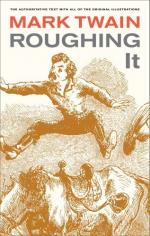Once we made twenty-five miles in a day, and once we made forty miles (through the Great American Desert), and ten miles beyond—fifty in all —in twenty-three hours, without halting to eat, drink or rest. To stretch out and go to sleep, even on stony and frozen ground, after pushing a wagon and two horses fifty miles, is a delight so supreme that for the moment it almost seems cheap at the price.
We camped two days in the neighborhood of the “Sink of the Humboldt.” We tried to use the strong alkaline water of the Sink, but it would not answer. It was like drinking lye, and not weak lye, either. It left a taste in the mouth, bitter and every way execrable, and a burning in the stomach that was very uncomfortable. We put molasses in it, but that helped it very little; we added a pickle, yet the alkali was the prominent taste and so it was unfit for drinking.
The coffee we made of this water was the meanest compound man has yet invented. It was really viler to the taste than the unameliorated water itself. Mr. Ballou, being the architect and builder of the beverage felt constrained to endorse and uphold it, and so drank half a cup, by little sips, making shift to praise it faintly the while, but finally threw out the remainder, and said frankly it was “too technical for him.”
But presently we found a spring of fresh water, convenient, and then, with nothing to mar our enjoyment, and no stragglers to interrupt it, we entered into our rest.
CHAPTER XXVIII.
After leaving the Sink, we traveled along the Humboldt river a little way. People accustomed to the monster mile-wide Mississippi, grow accustomed to associating the term “river” with a high degree of watery grandeur. Consequently, such people feel rather disappointed when they stand on the shores of the Humboldt or the Carson and find that a “river” in Nevada is a sickly rivulet which is just the counterpart of the Erie canal in all respects save that the canal is twice as long and four times as deep. One of the pleasantest and most invigorating exercises one can contrive is to run and jump across the Humboldt river till he is overheated, and then drink it dry.
On the fifteenth day we completed our march of two hundred miles and entered Unionville, Humboldt county, in the midst of a driving snow-storm. Unionville consisted of eleven cabins and a liberty-pole. Six of the cabins were strung along one side of a deep canyon, and the other five faced them. The rest of the landscape was made up of bleak mountain walls that rose so high into the sky from both sides of the canyon that the village was left, as it were, far down in the bottom of a crevice. It was always daylight on the mountain tops a long time before the darkness lifted and revealed Unionville.
We built a small, rude cabin in the side of the crevice and roofed it with canvas, leaving a corner open to serve as a chimney, through which the cattle used to tumble occasionally, at night, and mash our furniture and interrupt our sleep. It was very cold weather and fuel was scarce. Indians brought brush and bushes several miles on their backs; and when we could catch a laden Indian it was well—and when we could not (which was the rule, not the exception), we shivered and bore it.




